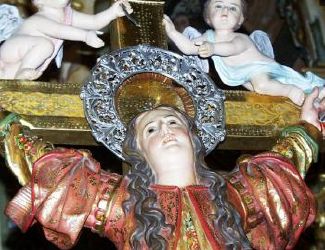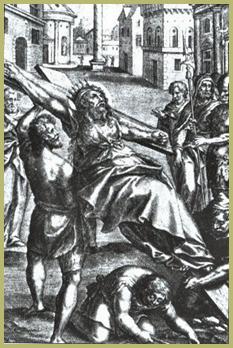Saint Wilgefortis

Also known as Saint Uncumber
Legend says she was a Christian daughter of a pagan King of Portugal. In order to keep her vow of chastity, she prayed that God would disfigure her body, so she might evade the command of her father to marry a pagan prince. God caused a beard to grow on her chin, whereupon her father had her crucified.
Connected with this legend is the story of a destitute fiddler to whom, when he played before her image (or perhaps  before her crucified body), she gave one of her golden boots. Being condemned to death for the theft of the boot, he was granted his request to play before her a second time, and, in presence of all, she kicked off her other boot, which established his innocence.
before her crucified body), she gave one of her golden boots. Being condemned to death for the theft of the boot, he was granted his request to play before her a second time, and, in presence of all, she kicked off her other boot, which established his innocence.
The legend cannot be traced back further than the fifteenth century. It its believed that it originated from a misinterpretation of the famous "Volto Santo" of Lucca, a representation of the crucified savior, clothed in a long tunic, wearing a crown and looking rather androgynous.
The name Wilgefortis is said to derive from the phrase Hilge Vartz (Vartz, Fratz, face), "Holy Face". The old English name Saint Uncumber, and the equivalents in other languages, rose from the popular belief that every one who invokes the saint in the hour of death will die without anxiety or regret.
Her feast was celebrated on 20 July. The Roman Catholic Church removed her commemoration in the liturgical reform of 1969. She is usually represented nailed to a cross: as a girl of ten or twelve years, frequently with a beard, or as throwing her golden boot to a musician playing before her, sometimes also with one foot bare.
1 comment:
Lord, let me grow a beard.
Hey, it worked!
Post a Comment